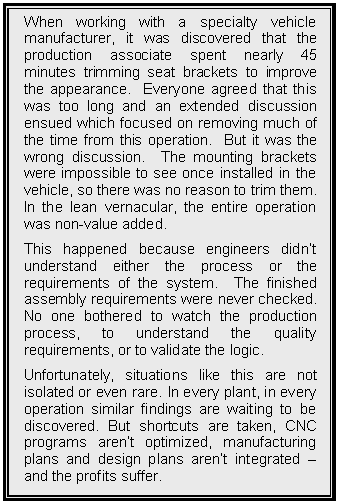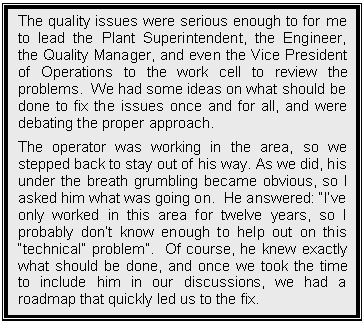|
The Role of Engineering in Manufacturing
Improvement
Click here for PDF version
Engineers must have a thorough understanding of the manufacturing process as well as the design process. The gains that are
achievable by paying close attention to the processes are surprising. Indeed, while it’s true that the emphasis on manufacturing
improvements and on deploying lean thinking in our workplaces has had a dramatic effect on the productivity of manufacturing
processes, these gains are only a primer for what can happen when design solutions are successfully integrated with the
manufacturing processes. The interface between product development and manufacturing operations offer one of the biggest
opportunities for improvement in our facilities. Just as 5S serves as an introduction to a full-fledged lean deployment, design
and process integration serve as an introduction to facility wide lean transformation.
The Good Engineers...
 With
access to powerful CAD systems, it is easy for engineers and designers to stay at their computers, theorizing about the best way
to make the parts and assemblies. But here’s the catch; design which doesn’t comprehend the details of the manufacturing
process is not engineering; it is merely creative drawing. Likewise, when designing products “on the floor”, obsolete and
outdated process assumptions cannot be challenged. It becomes difficult to develop a good understanding of the effects and
causes of variation. Without detailed design work, little improvement is made; parts won’t fit together, and real
improvement from previous projects cannot be made. With
access to powerful CAD systems, it is easy for engineers and designers to stay at their computers, theorizing about the best way
to make the parts and assemblies. But here’s the catch; design which doesn’t comprehend the details of the manufacturing
process is not engineering; it is merely creative drawing. Likewise, when designing products “on the floor”, obsolete and
outdated process assumptions cannot be challenged. It becomes difficult to develop a good understanding of the effects and
causes of variation. Without detailed design work, little improvement is made; parts won’t fit together, and real
improvement from previous projects cannot be made.
So what are we to do? The only answer is to immediately start
forcing the issue by bringing the design elements into compatibility with the manufacturing processes. Designs must be
completed with the manufacturing processes in mind.
While working on a project with Toyota, their assistant chief
engineer summed it up “Brian”, be asked, “Do you know the difference between a good engineer and a bad engineer?” He continued,
“A good engineer has to wash his hands before he goes to the bathroom”.
Use lean techniques to completely understand the process
In complex, multi-stepped processes, it isn’t unusual to discover
that no one completely understands all the details from start to finish. Why is each step taken? Why are they taken in this
particular sequence? Are certain techniques especially critical to success? When tools are required, how should they be set up,
maintained or staged? Without satisfactory answers to these questions, it is doubtful that there is an adequate understanding of
the process. In new product development projects, the same questions apply – they’re just much harder to answer.
An Illustration from my files: As engineering director of a large tier one automotive supplier, I had grown concerned with
the efficiency of the process used to manufacture a component for one of our automotive customers. The numbers were good and
improving. We had exceeded our productivity goals and quality goals for months in a row. Our delivered quality to the customer
was outstanding, and we had been awarded both the design and the production for the next generation of the product.
But observing the line, it was easy to see that we were manufacturing products in large, unwieldy batches rather than single part
flow. At my urging, it was decided that we would spend two weeks and conduct a detailed process review and develop a value stream
map of the workcell. As we walked through the line, we immediately started learning about our process. In the first station, the
parts were stored far away from the operator. In subsequent stations we found equipment maintenance problems, serious ergonomic
issues, worn out tools and non-value added operations.
As we continued through the line, we found multiple operations that added no-value; there was rework built into the line and
engineering specifications that were poorly done. After the two week review, we had identified over 100 major concerns. Two
months later, when the issues were resolved and the testing complete, we had improved productivity by 50%, reduced cost by $2
million annually, and improved our first pass quality yield from 95% to 99.5%. Most importantly, we now knew how to better design
the product and the process for the next generation.
Understand the requirements
There are many entities that place demands on our products. Customers have functional and aesthetic requirements, governmental
agencies have environmental, health and safety and reporting requirements, and we have internal standards. Don’t make the
assumption that you understand all of these requirements or know why a process step is taken or an engineering specification has
been applied. To be sure it is understood – go and see for yourself. In the earlier seat bracket example, anyone could have asked
the question “Can anyone see the mounting bracket once it is in the car?” But the question wasn’t asked because all the managers,
supervisors, engineers and operators already knew the answer – or so they thought. But their answer was wrong. It wasn’t until we
took the 5 minute “field trip” to look at a finished vehicle that the real requirements became known.
Of course, this was a simple solution. It isn’t always so easy to determine the real requirements. Sometime we need validation
tests, customer approvals, detailed engineering studies or design reviews to determine the requirements. In many cases you may
need to work through the concerns one-on-one with customers. But it’s always worth it.
 Listen to those who really know
Listen to those who really know
The most knowledgeable people in most manufacturing operations are the production, maintenance, and quality associates. But
managers and engineers routinely change processes, revise or replace equipment, change designs, or implement other “Continuous
Improvement” ideas without utilizing or even consulting these resources. This is a mistake. Even in the unlikely event that the
ideas of the engineers are superior to those of the workers, the results will be better when the workforce is involved in the
decision making and planning of the changes.
Establish the foundation for future improvements
As we go through the effort to learn about the process and the product and then implement the resulting improvements, it is
important to document what we have learned. Guidelines or checklists need to be established to make sure that the lessons learned
on this project do not get lost once the next generation product is designed.
In lean manufacturing we have found that significant gains are made when we take the effort to establish standardized work. By
performing the work in a consistent manner, the job gets gone quicker, the results are more predictable, and quality performance
improves. Additionally, when there is a problem, it can be more quickly identified and permanently rectified.
Design checklists are the standardized work for product development. The learnings, both positive and negative, from past
projects are compiled in the checklists. In some cases, the checklist will essentially define the “how to” of the design, giving
precise steps to be taken to ensure success. In other cases, the checklists will provide standardized solutions to common design
problems.
|

